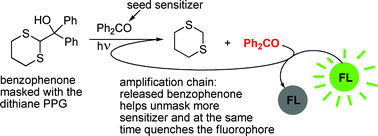Externally sensitized deprotection of PPG-masked carbonyls as a spatial proximity probe in photoamplified detection of binding events†‡
Abstract
Externally sensitized electron-transfer fragmentation in

- This article is part of the themed collection: Photoremovable protecting groups: development and applications

 Please wait while we load your content...
Please wait while we load your content...